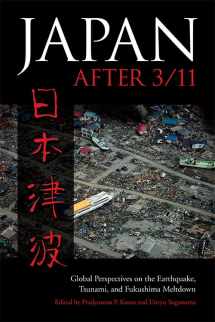
Japan after 3/11: Global Perspectives on the Earthquake, Tsunami, and Fukushima Meltdown (Asia in the New Millennium)
ISBN-13:
9780813167305
ISBN-10:
0813167302
Edition:
Illustrated
Author:
Pradyumna P. Karan, Unryu Suganuma
Publication date:
2016
Publisher:
University Press of Kentucky
Format:
Hardcover
496 pages
FREE US shipping
Book details
ISBN-13:
9780813167305
ISBN-10:
0813167302
Edition:
Illustrated
Author:
Pradyumna P. Karan, Unryu Suganuma
Publication date:
2016
Publisher:
University Press of Kentucky
Format:
Hardcover
496 pages
Summary
Japan after 3/11: Global Perspectives on the Earthquake, Tsunami, and Fukushima Meltdown (Asia in the New Millennium) (ISBN-13: 9780813167305 and ISBN-10: 0813167302), written by authors
Pradyumna P. Karan, Unryu Suganuma, was published by University Press of Kentucky in 2016.
With an overall rating of 3.7 stars, it's a notable title among other
books. You can easily purchase or rent Japan after 3/11: Global Perspectives on the Earthquake, Tsunami, and Fukushima Meltdown (Asia in the New Millennium) (Hardcover) from BooksRun,
along with many other new and used
books
and textbooks.
And, if you're looking to sell your copy, our current buyback offer is $0.3.
Description
On March 11, 2011, an underwater earthquake off the Pacific coast of Tohoku, Japan, triggered one of the most devastating tsunamis of a generation. The aftermath was overwhelming: communities were reduced to rubble, thousands of people were missing or dead, and relief organizations struggled to reach affected areas to provide aid for survivors and victims of radiation from compromised nuclear reactors.In Japan after 3/11, editors Pradyumna P. Karan and Unryu Suganuma assemble geographers, economists, humanists, and scientists to consider the complex economic, physical, and social impacts of this heartbreaking disaster. Historical geographers place the events of March 2011 in context, while other contributors assess the damage and recommend strategies for the long process of reclamation and rebuilding. The book also includes interviews with victims that explore the social implications of radioactive contamination and invite comparisons to the discrimination faced by survivors of the Hiroshima and Nagasaki bombings. Balancing the natural and social sciences, this timely volume offers not only a model of interdisciplinary research for scholars but also an invaluable guide to the planning and implementation of reconstruction.


We would LOVE it if you could help us and other readers by reviewing the book
Book review

Congratulations! We have received your book review.
{user}
{createdAt}
by {truncated_author}


